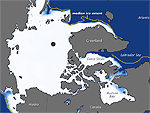While extreme weather conditions and unusually cold temperatures have gripped much of North America and Europe this winter, unusually warm temperatures farther north produced the lowest Arctic sea ice extent ever recorded for the month of January, according to NASA. Areas such as Hudson Bay, Hudson Strait, and Davis Strait — which typically freeze over by late November — did not completely freeze until mid-January, according to the National Snow and Ice Data Center (NSIDC). And the Labrador Sea was also unusually ice-free. In this NASA graphic (right), based on satellite data, blue indicates open water, white illustrates high sea ice concentrations, and turquoise indicates loosely packed ice. The yellow line indicates the average January sea ice extent from 1979 through 2000. Scientists say the bizarre weather may be the result of a shift in a climate pattern known as the Arctic Oscillation, which has led to frigid Arctic air pouring south across North America and Europe while regions in the Arctic have been unusually warm.
Arctic Sea Ice Extent in January is Lowest in Recorded History, NASA Says
More From E360
-
WILDLIFE
A Troubling Rise in the Grisly Trade of a Spectacular African Bird
-
MINING
In Myanmar, Illicit Rare Earth Mining Is Taking a Heavy Toll
-
INTERVIEW
How Batteries, Not Natural Gas, Can Power the Data Center Boom
-
ANALYSIS
As U.S. and E.U. Retreat on Climate, China Takes the Leadership Role
-
Solutions
From Ruins to Reuse: How Ukrainians Are Repurposing War Waste
-
ANALYSIS
Carbon Offsets Are Failing. Can a New Plan Save the Rainforests?
-
Energy
Facing a Hostile Administration, U.S. Offshore Wind Is in Retreat
-
Biodiversity
As Jaguars Recover, Will the Border Wall Block Their U.S. Return?
-
WATER
An E.U. Plan to Slash Micropollutants in Wastewater Is Under Attack
-
INTERVIEW
This Data Scientist Sees Progress in the Climate Change Fight
-
Climate
As Floods Worsen, Pakistan Is the Epicenter of Climate Change
-
Climate
Heat Stress Is a Major Driver of India’s Kidney Disease Epidemic
